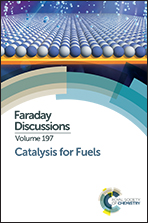Carbon induced selective regulation of cobalt-based Fischer–Tropsch catalysts by ethylene treatment†
Abstract
Various carbonaceous species were controllably deposited on Co/Al2O3 catalysts using ethylene as carbon source during the activation process for Fischer–Tropsch synthesis (FTS). Atomic, polymeric and graphitic carbon were distinguished by Raman spectroscopy, thermoanalysis and temperature programmed hydrogenation. Significant changes occurred in both the catalytic activity and selectivity toward hydrocarbon products after ethylene treatment. The activity decreased along with an increase in CH4 selectivity, at the expense of a remarkable decrease of heavy hydrocarbon production, resulting in enhanced selectivity for the gasoline fraction. In situ XPS experiments show the possible electron transfer from cobalt to carbon and the blockage of metallic cobalt sites, which is responsible for the deactivation of the catalyst. DFT calculations reveal that the activation barrier (Ea) of methane formation decreases by 0.61 eV on the carbon-absorbed Co(111) surface, whereas the Ea of the CH + CH coupling reaction changes unnoticeably. Hydrogenation of CHx to methane becomes the preferable route among the elementary reactions on the Co(111) surface, leading to dramatic changes in the product distribution. Detailed coke-induced deactivation mechanisms of Co-based catalysts during FTS are discussed.
- This article is part of the themed collection: Catalysis for Fuels

 Please wait while we load your content...
Please wait while we load your content...